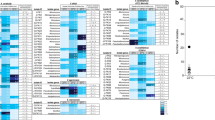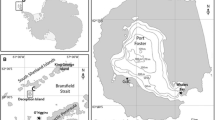Abstract
Potential sources of mortality of marine invertebrate larvae are numerous and include predation and diseases caused by marine microorganisms. Extracts from the eggs of 11 coral species were evaluated for their ability to deter surface attachment and inhibit the growth of two marine tolerant laboratory bacteria and 92 bacterial strains isolated from seawater and the surface of coral colonies on the Great Barrier Reef (GBR). Extracts of the eggs of Montipora digitata inhibited the growth of the two laboratory bacteria, Vibrio harveyii and Bacillus subtilis, and one bacterial isolate from the mucus of the coral Favia pallida in disc diffusion and liquid culture assays. No other microbial strains (n=91) from the surface of corals and the reef environment were inhibited by M. digitata extracts. No antibacterial activity was found in the egg extracts of the remaining ten coral species and none of the extracts inhibited surface attachment of various bacteria. Extrapolation of estimated surface concentrations of the biologically active extract of M. digitata suggests that the level of the growth inhibitory compounds may be sufficient to deter microbial growth in situ.


Similar content being viewed by others
References
Alam N, Bae BH, Hong JK, Lee CO, Im KS, Jung JH (2001) Cytotoxic diacetylenes from the stony coral Montipora species. J Nat Prod 64:1059–1063
Antonius A (1985) Coral diseases in the Indo-Pacific: a first record. Mar Ecol 6(3):197–218
Arai T, Kato M, Heyward A, Ikeda Y, Iizuka T, Maruyama T (1993) Lipid composition of positively buoyant eggs of reef building corals. Coral Reefs 12:71–75
Babcock RC, Baird AH, Piromvaragorn S, Thomson DP, Willis BL (2003) Identification of scleractinian coral recruits from Indo-Pacific reefs. Zool Stud 42:211–226
Bae BH, Im KS, Choi WC, Hong JK, Lee CO, Choi JS, Son BW, Song JI, Jung JH (2000) New acetylenic compounds from the stony coral Montipora sp. J Nat Prod 63:1511–1514
Baird AH, Pratchett MS, Gibson DJ, Koziumi N, Marquis CP (2001) Variable palatability of coral eggs to a planktivorous fish. Mar Freshwater Res 52:865–868
Bowden BF, Coll J, Tapiolas DM, Willis RH (1985) Some chemical aspects of spawning in alcyonacean corals. In: Proceedings 5th international coral reef Congress, vol 4. pp 325–330
Ciereszko LS (1989) Sterol and diterpenoid production by zooxanthellae in coral reefs: a review. Biol Ocean 6:363–374
De Nys R, Steinberg PD, Willemsen P, Dworjanyn SA, Gabelish CL, King RJ (1995) Broad spectrum effects of secondary metabolites from the red alga Delisea pulchra in antifouling assays. Biofouling 8:259–271
Fearon RJ, Cameron AM (1996) Larvotoxic extracts of the hard coral Goniopora tenuidens: allelochemicals that limit settlement of potential competitors? Toxicon 34:361–367
Fusetani N, Toyoda T, Asai N, Matsunaga S, Maruyama T (1996) Montiporic acids A and B, cytotoxic and antimicrobial polyacetylene carboxylic acids from eggs of the scleractinian coral Montipora digitata. J Nat Prod 59:796–797
Gil-Turnes MS, Fenical W (1992) Embryos of Homarus americanus are protected by epibiotic bacteria. Biol Bull 182:105–108
Givskov M, De Nys R, Manefield M, Gram L, Maximillien R, Eberl L, Molin S, Steinberg PD, Kjelleberg S (1996) Eukaryotic interference with homoserine lactone-mediated prokaryotic signalling. J Bacteriol 178(22):6618–6622
Gregersen T (1978) Rapid method for distinction of Gram-negative from Gram-positive bacteria. Eur J Appl Microbiol Biotechnol 5:123–127
Gunthorpe L, Cameron AM (1990a) Intracolonial variation in toxicity in scleractinian corals. Toxicon 28:1221–1227
Gunthorpe L, Cameron AM (1990b) Toxic exudate from the hard coral Goniopora tenuidens. Toxicon 28:1347–1350
Gunthorpe L, Cameron AM (1990c) Widespread but variable toxicity in scleractinian corals. Toxicon 28:1199–1219
Harrison PL, Wallace CC (1990) Reproduction, dispersal and recruitment of scleractinian corals. In: Dubinsky Z (ed) Coral reefs. Elsevier, Amsterdam, pp 133–207
Harvell CD, West JM, Griggs C (1996) Chemical defense of embryos and larvae of a West Indian Gorgonian coral, Briareum Asbestinum. Invert Reprod Dev 30(1–3):239–247
Hodgson G (1990) Tetracyline reduces sedimentation damage to corals. Mar Biol 104(3):493–496
Holmström C, Kjelleberg S (1999) Marine Pseudoalteromonas species are associated with higher organisms and produce biologically active extracellular agents. FEMS Microbiol Ecol 4:285–293
Holmström C, James S, Neilan BA, White DC, Kjelleberg S (1998) Pseudoalteromonas tunicata sp nov a bacterium that produces antifouling agents. Int J Syst Bacteriol 48:1205–1212
Holmström C, Egan S, Franks A, McCloy S, Kjelleberg S (2002) Antifouling activities expressed by marine surface associated Pseudoalteromonas species. FEMS Microbiol Ecol 41:47–58
Jensen P, Harvell C, Wirtz K, Fenical W (1996) Antimicrobial activity of extracts of Caribbean gorgonian corals. Mar Biol 125:411–419
Kelman D, Kushmaro A, Loya Y, Kashman Y, Benayahu Y (1998) Antimicrobial activity of a Red Sea soft coral, Parerythropodium fulvum fulvum: reproductive and developmental considerations. Mar Ecol Prog Ser 169:87–95
Koh EGL (1997) Do scleractinian corals engage in chemical warfare against microbes? J Chem Ecol 23:379–398
Kushmaro A, Loya Y, Fine M, Rosenbberg E (1996) Bacterial infection and coral bleaching. Nature 380(6573):396
Kushmaro A, Banin E, Loya Y, Stackebrandt E, Rosenberg E (2001) Vibrio shiloi sp nov., the causative agent of bleaching of the coral Oculina patagonica. Int J Syst Evol Micro 51:1383–1388
Lindquist N (2002) Chemical defense of early life stages of benthic marine invertebrates. J Chem Ecol 28:1987–2000
Maximilien R, de Nys R., Holmstrom C, Gram L, Givskov M, Crass K, Kjellebeger S, Steinberg PD (1998) Chemical mediation of bacterial surface colonisation by secondary metabolites from the red alga Delisea pulchra. Aquat Microb Ecol 15(3):233–246
Mitchell R, Chet I (1975) Bacterial attack of corals in polluted seawater. Microb Ecol 2:227–233
Pratchett MS, Baird AH, Marquis CP (2002) Comparative palatability of coral eggs. In: Proceedings of 9th international coral reef symposium, vol 1. pp 391–394
Russell AD, Quesnel LB (1983) Antibiotics: assessment of antimicrobial activity and resistance. Academic, London
Segal LA, Ducklow HW (1982) A theoretical investigation into the influence of sublethal stresses on coral-bacterial ecosystem dynamics. Bull Mar Sci 32(4):919–935
Slattery M, McClintock JB, Heine JN (1995) Chemical defenses in Antarctic soft corals: evidence for antifouling compounds. J Exp Mar Biol Ecol 190(1):61–77
Steinberg PD, de Nys R, Kjelleberg S (2001) Chemical mediation of surface colonization in Marine Chemical Ecology In: McClintock JB, Baker BJ (eds) CRC Press, Boca Raton, pp 355–387
Steinberg PD, de Nys R, Kjelleberg S (2002) Chemical cues for surface colonization. J Chem Ecol 28(10):1935–1951
Willis BL, Babcock RC, Harrison PL, Oliver JK (1985) Patterns in the mass spawning of corals on the Great Barrier Reef from 1981 to 1984. In: Proceedings of 5th international coral reef congress, vol 4. pp 343–348
Zar JH (1999) Biostatistical analysis, 4th edn. Prentice Hall, Upper Saddle River
Acknowledgements
This project was funded by an ARC Small Grant (UNSW) to CPM, R de N and AHB and a Project Aware Foundation Grant to CPM. We thank the staff at Orpheus Island Research Station for their assistance and support. M and D Pratchett provided invaluable assistance in the field. This is contribution number 270 of the Coral Ecology Group at James Cook University and 117 of the Centre for Coral Reef Biodiversity.
Author information
Authors and Affiliations
Corresponding author
Additional information
Communicated by Biological Editor H.R. Lasker
Rights and permissions
About this article
Cite this article
Marquis, C.P., Baird, A.H., de Nys, R. et al. An evaluation of the antimicrobial properties of the eggs of 11 species of scleractinian corals. Coral Reefs 24, 248–253 (2005). https://doi.org/10.1007/s00338-005-0473-7
Received:
Accepted:
Published:
Issue Date:
DOI: https://doi.org/10.1007/s00338-005-0473-7




